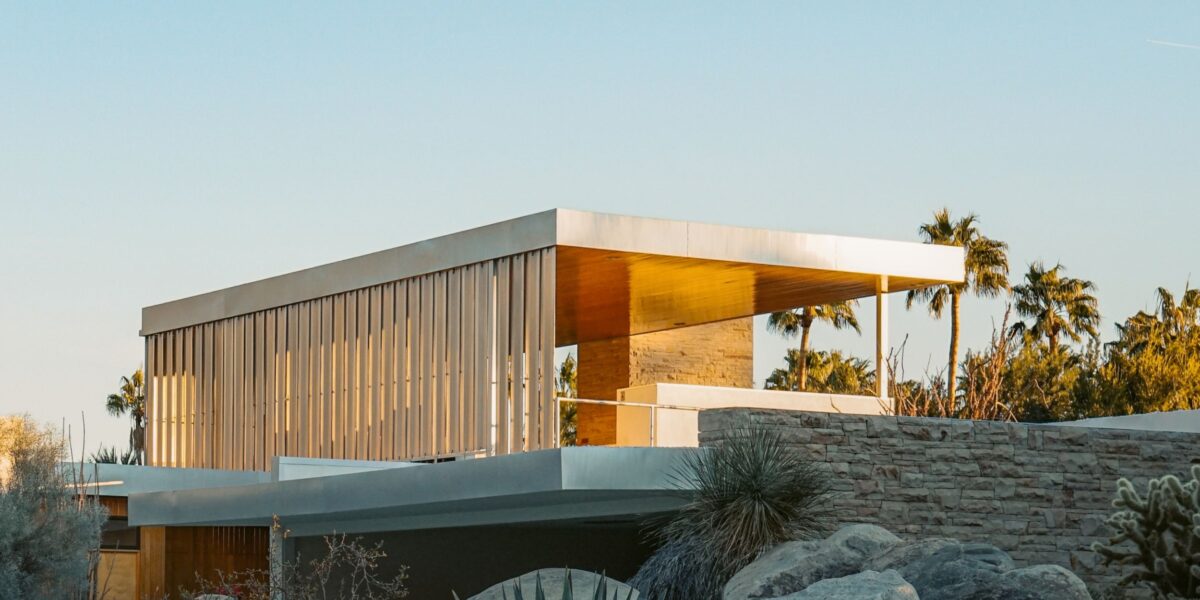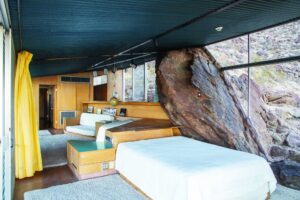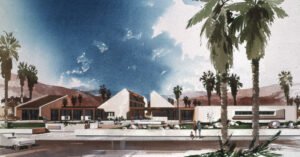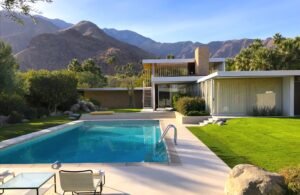
A Guide to Mid-Century Modern Design in Palm Springs
Too often oversimplified as a glamorous desert oasis with an overabundance of golf courses, Palm Springs has many fascinating layers to peel back. For starters, its location is a geological wonderland, with the nearby San Andreas fault providing a dividing line between the Sonoran and Mojave Deserts, and the towering San Jacinto Mountains provide a dramatic desert backdrop. Perhaps inspired by this natural canvas, the town has a long history of forward-thinking art, design, music and, perhaps most notably, architecture. Palm Springs boasts the largest concentration of mid-century modern architecture in the country and we spoke to a leading expert to learn more.
What is Mid-Century Modern Architecture?

Frey House II by Albert Frey
All Roads North spoke to mid-century modern expert Brad Dunning, who is curating an upcoming exhibition on prominent mid-century modern architect Albert Frey at the Palm Springs Art Museum.
“Mid-century modern is a term used to roughly describe the dominant new style in graphic design, interior design and architecture from the period right after WWII until post modernism which raised its confounding head in the 70s which was in response or reaction to mid-century modernism,” Dunning said.
The most recognizable features of mid-century modern design include clean lines, simple forms, and the use of new materials like concrete, steel, and glass. Bright colors and bold geometric shapes are also common, as is an emphasis on living spaces that flow seamlessly from indoors to outdoors. In every element, the style aspires to a seamless connection between the surrounding landscape and the built environment.
The History of Mid-Century Modern Design

A rendering of Tahquitz Plaza designed by Hugh Kaptur and Larry Lapham, 1973-1974
Mid-century modern design emerged in the 1950’s and 1960’s in Palm Springs, a period of post-World War II prosperity and optimism when the possibility of owning a second home became more attainable.
Although mid-century modern design is mostly considered to have been born in the U.S., Dunning said that the designs and philosophies of an influential German design school called Bauhaus served as the main touchstone for the style. The school favored unadorned, pure design, leaving behind superfluous decoration and ornamentation.
Mid-Century Modern Architecture In Palm Springs

The Kaufmann House
“The sun, the pure air, and the simple forms of the desert create perfect conditions for architecture.” – Albert Frey, 1903
The desert landscapes and the forward-thinking spirit of California provided the perfect setting for mid-century modern architecture to thrive in Palm Springs. Due to post-war prosperity and optimism, the “leisure class” lifestyle was available to middle and upper class citizens like never before. Plus, technological advances and social trends– such air conditioning and the popularity of golf– set the scene for Palm Springs’ fate as a seasonal destination. The desert town came to be a popular getaway for Hollywood celebrities and other affluent individuals seeking a glamorous lifestyle. Several stars– the likes of Marilyn Monroe, Elvis Presley and Frank Sinatra– frequented the Palm Springs.
“Being second homes, the owners [of new houses in Palm Springs] were more willing to embrace or consider a more flamboyant or daring design since the home was not reflecting their more staid or conservative lifestyle back home, reflected in their main residences,” Dunning said.
Several architects were key in shaping the development of mid-century architecture’s popularity in Palm Springs.
“Swiss-born and Le Corbusier-trained architect Albert Frey paved the way for what is now known as the “Palm Springs School”– a once-in-a lifetime coalescence of highly talented and inventive architects who did residential and commercial architecture all in the small desert town,” Dunning said. “Locals like William Cody and Donald Wexler, and travelers from nearby Los Angeles like John Lautner and Richard Neutra.”
The architects and designers who worked in Palm Springs during this era drew inspiration from the desert landscape, incorporating natural materials and creating spaces that blurred the boundaries between indoors and outdoors.
Some of Frey’s most notable mid-century works include Frey House II and the Tramway Gas Station. Neutra’s iconic buildings include the Kaufmann House and the Grace Lewis Miller House.
The Future of Mid-Century Modern

Although mid-century modern design initially developed and gained popularity in the 50’s and 60’s, the style was rediscovered in the late 80’s, and the popularity shows little signs of waning, Dunning said.
“Many, myself included, now posit that 20th century mid-century style is the dominant design direction and influence even now well into the 21st century, and, in fact, it may be a bigger overall movement than when it was when it was in its nascent stages decades ago,” Dunning said. “I keep waiting for the midcentury wave to break but right now people are still surfing the crest ….and still enjoying the ride.”
For a unique look into Palm Springs’ mid-century modern history, All Roads North will connect you to experts in the field who provide an insider’s look into the most beautiful and architecturally significant neighborhoods of Palm Springs. You’ll be able to step inside stunning private residences, iconic buildings and more. Begin planning your own custom Palm Springs journey here!
